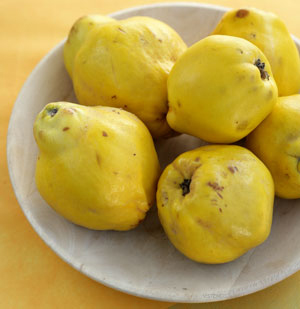Quince is one of the oldest fruits prominent in the Greek region’s nutritional history. It has had a special place in the country’s sweet tradition since antiquity and has only recently been slightly overlooked by culinary practices. Nowadays it often causes awkwardness among chefs as to what it could be used in other than the production of the famous “kidoni” (κυδώνι) spoon sweet. Yet quince conceals many hidden qualities and an astonishing historical path connected to greek tradition in general and surpassing the limits of its nutritional existence.
Quince is the fruit Eris gave to Paris when she requested of him to offer it to the most beautiful out of three ancient Greek Goddesses, Athena, Artemis and Aphrodite. The promise Aphrodite gave him in order to secure the precious fruit for herself was the cause of the treacherous ten year Trojan War. If Paris was to select Aphrodite as the rightful bearer of a prize with such connotations the godess would make sure he would have one of the most beautiful mortal women of the time, Eleni. “The apple of discord” was no apple but in fact a rather troublesome quince. It was through this story however that the quince was connected to the concept of love, something which was possibly considered by Solon, the famous athenian legislator, when he added the use of the fruit to the wedding ceremony. In the region of Thrace today, as a reminder of ancient habits, newlyweds share a quince before going to bed in order to wake with sweet breath on their first morning as a wedded couple.
Quince, cydonia oblonga, is of the apple and pear family and like them it originated in the Caucasian region slowly making its way towards the East and the Mediterranean. It’s original greek name was “strouthia” (στρούθια, στρούθεια) but when the region of Cydonia (Κυδωνία) on the island of Crete started growing it with huge success it adopted the name “kidoni” (κυδώνι). It bears gorgeous flowers in spring, but emerges as an odd-looking amorphous fruit in the fall, smooth and bumpy, sporting grayish-green fuzz when young, losing it as maturity arrives.
Quince has lost most of its popularity in modern Greece due to the fact that few people have the time and energy to make homemade jams, a practice in which the fruit plays a significant role. Picked off the tree quince is a tight, dry skinned fruit which contains little sugar and doesn’t make a very appetizing snack. However, when cooked, its smooth textured flesh takes on a deep shade of pink and releases rich aroma while its thickening properties act as a jelling agent and make it an excellent ingredient used in fruit composts and jam.Quince jam is great with strong cheese, such as aged kasseri and aged graviera. “Marmelada” (μαρμελάδα), the Greek word for jam, essentially derives from the portuguese word for quince, marmelo.
In the Greek kitchen quince is stuffed with ground meat, a classic Asia Minor recipe. It can also be cooked like potatoes with olive oil and tomatoes. In Lefkada, we find two of the most unusual recipes for quince: the first is the local rendition of sofegada, in which the fruit is stewed with beef, potatoes, rosemary and petimezi. In another Lefkada recipe, quince is cooked with eggplant and sweet potatoes. Quince pairs up amazingly with chestnuts in both sweet and savory seasonal dishes. Kozani stakes a claim on “ladera” made with quince as the main ingredient, but arguably the country’s most unusual quince pairing is with octopus in a dish from Pelion.
How to select and store quince: Select fruit that are large, firm, and yellow with little or no green. Quinces should be picked when full-yellow and firm. Quinces must be handled carefully as they bruise easily. Wrap quinces in a plastic bag and refrigerate them for up to 2 months.






